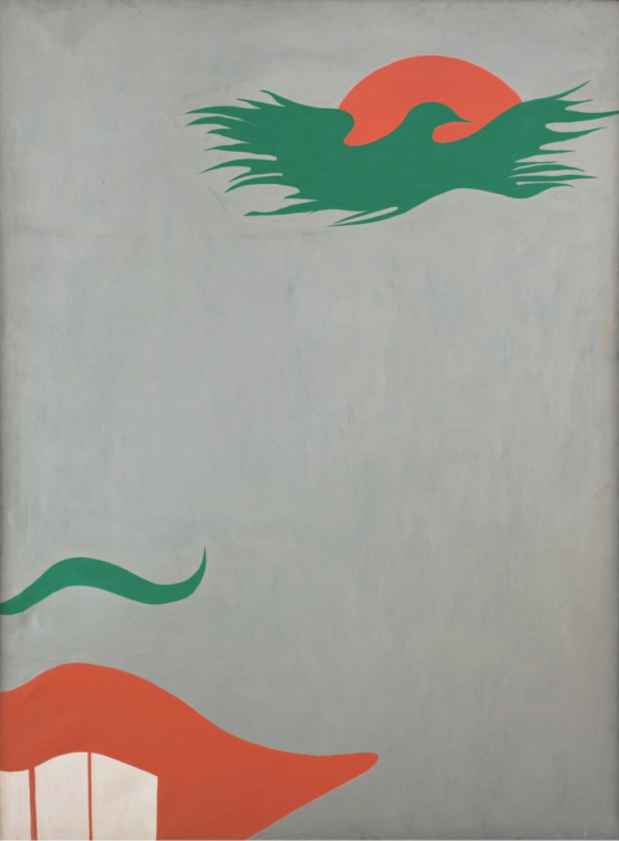Jerzy “Jurry" Zieliński Exhibition
Oko

This event has ended.
In paintings that conflate the aesthetics of Communist propaganda with the signifiers of Pop Art and tropes of Art Nouveau, Polish artist and poet Jerzy Ryszard “Jurry” Zieliński (1943-1980) deployed an esoteric series of symbols to explore life’s grand themes of national identity, religion, eroticism and politics. Strategically paring his palette down to flattened areas of red, white, blue and green, and working with a visual language of repeated emblems, Zieliński departed radically from the somberness expected of Polish art. One of the rare Polish artists to take up the Pop Art style during the 1960s and ‘70s, he made works suggesting a sly reverse psychology and replete with potent anti-Establishment messages. Owing to its radical intent, Zieliński’s work has long been expunged from the Polish art historical mainstream and is only just receiving recognition internationally for its relationship to the wider tides of postwar art.
Beginning April 10, 2013, Oko will open the very first American presentation devoted to this pivotal figure. Jerzy “Jurry Zieliński will fill the gallery’s vest pocket-sized East Village space with three key paintings that together offer a condensed first look at Jurry Zieliński’s oeuvre. The exhibition, which will remain on view through May 4th, was organized in collaboration with Galeria Zderzak, Krakow, and the artist’s widow Wieslawa Zielińska - Janiak.
In 1967, Zieliński and his art school colleague Jan Dobkowski allied themselves under the heading of Neo-Neo-Neo, an ironic moniker highlighting their belief that nothing in the accepted prevailing style of the Warsaw Fine Arts Academy was new or daring. “Neo-Neo-Neo is not a doctrine,” they wrote. “It is a call, we call for egalitarian art: does nobody have the courage to physiologically feel the urge to create?” Zieliński coined the American sounding nickname "Jurry" and Dobkowski dubbed himself “Dobson,” Westernizations that constituted political actions in themselves. After several common projects, the two artists parted ways and Neo-Neo-Neo soon faded from the memory of the Polish art world. But Zieliński continued to explore his fundamental concerns through writing and painting.
For Zieliński the distilled language of Pop Art was an ideal vehicle toward a distinctive personal style that was shot through with witty, incisive comments on the dilemmas of the age. While Pop Art in the West was primarily concerned with consumer culture and mass media, Zieliński’s version investigated an all-together more austere set of political concerns. The purposeful simplification and reliance upon stylized symbols in Zieliński’s canvases functioned in direct opposition to Poland’s national doctrine of Social Realism, which informed ‘acceptable’ painting both before and after the Stalinization of Communist Poland. Appropriating the familiar iconography of Communist propaganda posters, Zieliński converted the power of a limited visual syntax into social critique. To underline his dissent, Zieliński dubbed himself “Jurry – Polska B,” referencing the historical, political and cultural distinction between his nation’s more favored, developed and powerful west (Poland A) and its economically and socially downtrodden east (Poland B).
Though Zieliński was certainly aware of the conventions of American Pop Art, his use of the movement’s familiar images – lips, birds and other simplified symbols – is far removed from the works of John Pasche, Andy Warhol and Tom Wesselman. In Zieliński’s paintings, a mouth always offers double meaning, telegraphing not only lurid possibilities but also a powerful message about the illusions of double-talk offered under the rubric of Communism and Soviet domination. Transcending monolithic interpretation, Zieliński’s sometimes grotesque, sometimes humorous, and always lush paintings reference the dualities of hedonism and asceticism, pleasure and protest. By limiting his iconography to symbols already bloated with historical and social connotations, Zieliński was able to suggest that meaning can be reconfigured via context and intention.
Oko will present three works that address a selection of these symbols. In Ironia (Irony, 1970) an eye is fashioned of a silhouetted eagle, the national symbol of Poland and a frequent stand-in of the state. This bird crosses over a sun, beneath which sits the fraction of a toothy, smiling mouth. Polls Akt Malzenstwa (Polish Act of Marriage, 1974) features the faces of a man and a woman situated as the feet of a woman’s bent body in which the crux of a crucifix serves as the cleft of her ass. In Zaspokajanie (Meeting, 1969), the silhouette of an upturned face waits to catch a small drop of blood poised to fall from the top of the painting. Each of these works, despite their graphic simplicity, functions as the messenger of multiple meanings.
With Jerzy “Jurry” Zieliński, Oko will introduce Zieliński to a broader audience with works that testify to the enduring power of his art, even in this Post-Cold War era. This project provides a prelude to a larger exhibition devoted to the artist, scheduled to open at Luxembourg & Dayan London in October 2013.
Media
Schedule
from April 11, 2013 to May 04, 2013
Opening Reception on 2013-04-10 from 18:00 to 20:00